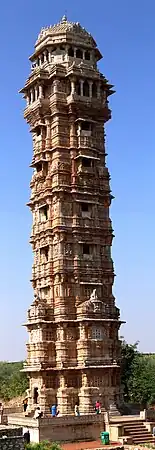Hindu Rajput kingdoms in the north-western Indian subcontinent resisted the Muslim invasions of India, beginning with the Umayyad campaigns from the Middle East and the Ghaznavid Turks from Central Asia. They continued resistance against subsequent Muslim empires, including the Arabs, Ghaznavids, Ghurids, Delhi Sultans and the Mughals.
Background
The Gurjara-Pratihara empire formed in the seventh century in the region called Gurjaradesa in modern-day Rajasthan after the Hunnic Invasions of North India and the death of Harsha. Its origins are debated but it could have formed out of the fusion of the Hunas and the native Indian tribes.[1][2] The Pratihara era lasted until the mid-eleventh century and was ended by the Ghaznavids.[3] From the Pratiharas and beyond, Rajputs rose to political prominence as the large empires of ancient India broke into smaller ones.[4][5] After the fall of the dynasty, several petty Rajput kingdoms became prominent in the region, such as the Chahamanas of Shakambhari, Guhilas of Ahar and Nagada, and the Paramaras.[6][7]
Umayyad Arab invasions
The Arabs, under the influence of the newly formed religion of Islam, began their political expansion during the life of Muhammad, the founder of Islam. By the seventh century, the Islamic State under Khalifas (Caliphs) spread all over Arabia, West Asia, North Africa and eastern Europe. They had conquered the ancient civilization of Persians and Egypt and had reached up to South Spain. In 711 A.D, Muhammad ibn Qasim, an Arab military commander of the Umayyad Caliphate defeated and executed Raja Dahir in the battle fought near Aror. The Arabs thus successfully conquered Sindh and Multan. There were several battles fought between the Arabs and the Rajputs. The one Rajput dynasty that came most in conflict with and repeatedly defeated the Arabs was that of the Pratihara dynasty. Under Nagabhata I, the Rajputs fought off an Arab invasion from Sindh, probably led by Junayd ibn Abd al-Rahman al-Murri or Al Hakam ibn Awana. Mewar under Bappa Rawal and later Khoman-II also fought off several Arab invasions.[8] [9]
Gopendraraja Chauhan a Rajput king belonging to the Chahamanas of Shakambari dynasty defeated Sultan Beg Varisa in a battle.Historian R. B. Singh theorizes that Beg Varisa might have been a subordinate of the Arab general Muhammad ibn Qasim.[10] Another king belonging to the Chahamanas of Shakmbari dynasty named Simharaja Chauhan defeated a Muslim general Heji-ud-Din, at Jethan (possibly modern Jethana a village in Ajmer). The Hammira Mahakavya calls him Hetim, and states that Simharaja captured four of his elephants after killing him. The identity of the defeated general is uncertain, but he might have been a subordinate of the Emir of Multan.[10]
Rajput resistance to early invasions
Bappa Rawal headed a confederated force of Rajputs that hindered the Arab invaders. The force had representation from almost all of the dynasties of northern India, including the Chauhans of Ajmer, Tomars of Delhi, Tak of Ahor, Chandels of Kalinjir, Guhils of Nagda (Udaipur), Chittorgarh forces of Maan Mori, Solankis of Patan, Bhatis of Bhatner (Punjab), Katochs of Jammu and Chavdas of Gujarat. Similar conjoined forces existed in later times, notably under Khoman of Mewar in the 8th century and under Jaipal Tuar of Delhi in the 9th century. However, infighting amongst the Rajputs eventually made resistance in north India very weak in the 10th century.
Ghaznavid invasions
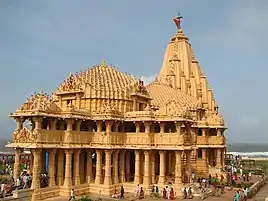
After the ninth century, the Turks, newly converted to Islam, had become more powerful than the Arabs.They launched several expeditions in the Indian Subcontinent and succeeded at first under Mahmud of Ghazni but were eventually defeated by the Rajputs in the Slaughter of Turushkas near Ajmer and Vigraharaja IV's first war against the Muslims.
The Ghaznavids under Mahmud Ghaznavi began their expansion at the Indian frontier. In the wake of the Gurjara Pratihara internal collapse, he raided India seventeen times, demolishing several temples and massacring civilians. He conquered Punjab after defeating the Kabul Shahis and undertook three expeditions into the Ganga Valley. The sole purpose of these raids were to loot wealth for his further Central Asian campaigns. By the end of 1015, Mahmud, aided by his feudatory rulers, crossed the foothills of the Himalayas and defeated a local Rajput king at Baran in modern-day western Uttar Pradesh. Moving towards Mathura, he was unsuccessfully opposed by a Kalachuri ruler, Kokkala-II, one of the major Rajput rulers of the area. Mahmud then plundered several temples in Mathura and ransacked the wealthy Pratihara capital of Kanauj in 1021 after defeating the king, Chandella Gauda. The Rajput rulers at Gwalior and Kalinjar were able to hold off assaults by Mahmud but the two cities did have to pay him heavy tribute.[11]
In 1025, Mahmud demolished and looted the Somnath Temple; its Rajput ruler, Bhima I, fled his capital at Anahilapataka.[12] The Rajput king Paramar Bhoj of Malwa assembled an army to attack him. However, Mahmud avoided the confrontation and never returned to India again.
Mahmmud during this campaign successfully captured the Punjab region and thus became first Islamic invader to control North-Western India. The Turks did not did not further expand their domain. In the latter half of the twelfth century, Ghaznavid power declined rapidly and they lost their control over their Central and West Asian territories. Despite this weakening, the Rajputs failed to show strategic insight and did not present a unified singular attack to recapture Punjab and the North West frontier. It was Shihabuddin Ghori who eventually captured Punjab from the Ghaznavids and then invaded Rajput territory in 1191.[13]

After Mahmud's invasion several Ghaznavid generals tried to invade India but were defeated by the Rajput Kings.Chamundaraja Chauhan defeated a Ghaznavid general named "Hejim-ud-Din". Prithviraja I defeated a Ghazanvid general named Baguli Shah possibly a suboordinate of Masud III sultan of Ghazna.[10] Ajayaraja II the founder of the city of Ajmer defeated Muslim generals Muhammad Bahlim or Salar Hussain suboordinates of the Ghazanavid king Bahram Shah.[14]
Ajayaraja's son Arnoraja Chauhan defeated the Ghazanvid King Bahram Shah in the Slaughter of Turushkas near Ajmer and is credited by the Ajmer prashasti inscription to have adorned Ajmer with the blood of Turushkas(Turkic people).The Prithviraja Vijaya also states that Arnoraja repulsed a Muslim invasion. According to the text, these invaders came through the desert, and had to drink the blood of their horses in absence of water. After defeating these invaders, Arnoraja purified the place of their death by commissioning a lake, which is identified with the modern Ana Sagar Lake. The lake was filled with the water of the Chandra river, identified with the modern Bandi River. Historian, R. B. Singh identifies the invader as the Ghaznavid king Bahram Shah.[10]
Bahram Shah's successor Khusrau Shah also led an expedition in the Rajput territory but was defeated by Vigraharaja the Great in Vigraharaja IV's first war against the Muslims.He reached as far as Vavvera, located six miles from Khetri village in Jaipur division of Rajasthan and invited Vigraharaja to submit to his authority, Srldhara, Vigraharaja's Chief Minister, proposed a diplomatic solution involving negotiations through financial means. However, Vigraharaja, driven by a strong sense of duty and honor, firmly rejected this approach as disgraceful. The ensuing conflict turned into a fierce battle, resulting in Vigraharaja's forces decisively defeating the Muslims and forcing them to retreat to their own dominions and annexed Hansi (Asika) from the Ghaznavids.[15]
Ghurid invasion

By the end of twelfth century, Ghurid dynasty under Shihabuddin Ghori defeated and executed the last of Ghaznavid rulers and captured their region along with plundering Ghazna, the capital of Ghaznavids.
The Ghurids first attacked India in 1178, where he was defeated by the Rajput confederation led by Mularaja Solanki and Naiki Devi in Battle of Kasahrada fought near Gujarat. He then came in conflict with the Chauhans of Ajmer and Delhi. By the end of 1190, Shihabuddin Ghori captured Bathinda, which formed a part of Chauhan's territory. In 1191, the Rajput king of Ajmer and Delhi, Prithviraj Chauhan, unified several Rajput states and decisively defeated the invading army of Shihabuddin Ghori near Taraori in the First Battle of Tarain.[16] Shihabuddin returned and in the Second Battle of Tarain (1192), Prithviraj Chauhan fell for Muhammad Ghori's diplomatic deception, accepting a truce. However, Ghori exploited the opportunity, launching a surprise attack at dawn, leading to Prithviraj's defeat and Ghori's decisive victory.[17] Prithviraj fled the battleground but was captured shortly after and was executed. Malesi, a Kachwaha Rajput of Jaipur, lead the last stand for Rajputs against the Ghorids after Prithviraj's escape.[18][19] In few years time by 1194, Shihabuddin advanced towards Kannauj and Banaras and defeated Jaichand (another major Rajput king of the time) in Battle of Chandawar despite being outnumbered again, Ghorids plundered down Varanasi (capital of Gahadavals) and destroyed several temples there. By 1198, Ghorids conquered Kannauj too. Shihabuddin left his conquests in India to his able Slave general Qutb ud Din Aibak and returned to Khorasan.[20]
The defeat of Rajputs was an important moment in medieval India's history as it not only shattered Rajput powers in the Indo-Gangetic Plain but also laid the foundation of Turkish rule in Ganga Valley.[20]
Following the battle, the Delhi Sultanate became prominent in the region and the collapse of organised Rajput resistance in northern India led to Muslim control of the region within a generation. However, Rajputs under the brief and able rule of Rana Sanga turned their traditional territory of Mewar into a powerful kingdom of north India.[21]
Delhi Sultanate
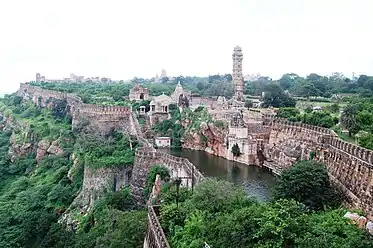
Mamluk Dynasty
During the reign of Iltutmish, the Rajput states of Kalinjar, Bayana, Gwalior, Ranthambore and Jalore rebelled against the Turkish governors and gained independence. In 1226, Iltutmish led an army to recapture the lost territories. He was successful in capturing Ranthambore, Jalore, Bayana and Gwalior. However, he was unable to conquer Gujarat, Malwa and Baghelkhand. Iltutmish also attempted an attack on Nagda, then capital of Mewar, but was repelled by the combined army of Mewar and Gujarat (under the Chalukyas).[22] After Iltutmish's death, the Rajput states once again rebelled, and the Bhati Rajputs, who were entrenched in Mewat, conquered the areas around Delhi.[23]
Khilji Dynasty
Sultan Ala ud din Khilji, who ruled between 1296 and 1316, conquered Gujarat in 1297, Malwa in 1305, and captured the fort of Mandu and handed it over to the Songara Chouhans. They captured the fortresses of Ranthambore in 1301, Mewar's capital at Chittorgarh in 1303, and Jalore in 1311, after long sieges with fierce resistance from their Rajput defenders. Khilji also fought the Bhati Rajputs of Jaisalmer and occupied the Golden Fort. He managed to capture three Rajput forts, Chitor, Ranthambore, Siwana and Jaisalmer, but could not hold them for long.[24] Alauddin despatched his generals against Karan Waghela, the Rajput ruler of Gujarat, who fled with his daughter to the court of Rai Ramachandra of Devagiri, where he was received cordially. However, Kamla Devi, the wife of ruler was captured by the invaders and she was married to Alauddin. In a bid to capture Karan Waghela, the army of sultanate attacked Devgiri under the generalship of Malik Kafur, the slave general of Alauddin. Ramchandra, the ruler of Devgiri was defeated and Deval Devi, the daughter of Rajput ruler Karan Waghela, was captured and brought to Delhi. Alauddin married Deval Devi to his son Khizar Khan.
Tuglaq Dynasty
Under Rana Hammir, the Mewar reestablished their supremacy within 20 years of the sack of Chittorgarh. In 1336, Hammir defeated Muhammad Tughlaq in the Battle of Singoli,[25] with the Hindu Charans as his main allies, and captured him. Tughlaq had to pay a huge ransom and relinquish all of Mewar's lands for his freedom. Following this, the Delhi Sultanate did not attack Chittorgarh for a few hundred years. The Rajputs reestablished their independence, and Rajput states were established as far as east and north into the Punjab. The Tomaras established themselves at Gwalior, and the ruler Man Singh Tomar built the fortress which still stands there. Mewar emerged as the leading Rajput state, and Rana Kumbha expanded his kingdom at the expense of the sultanates of Malwa and Gujarat.
 Built during the course of the 15th century by Rana Kumbha, the walls of the fort of Kumbhalgarh extend over 38 km, claimed to be the second-longest continuous wall after the Great Wall of China.
Built during the course of the 15th century by Rana Kumbha, the walls of the fort of Kumbhalgarh extend over 38 km, claimed to be the second-longest continuous wall after the Great Wall of China. City Palace was constructed by Maharana Udai Singh II after shifting his capital to Udaipur due to Muslim invasion.
City Palace was constructed by Maharana Udai Singh II after shifting his capital to Udaipur due to Muslim invasion..jpg.webp) Amer Fort and Jaigarh Fort are connected by subterranean passages, and are known for their artistic Hindu Rajput style elements.
Amer Fort and Jaigarh Fort are connected by subterranean passages, and are known for their artistic Hindu Rajput style elements.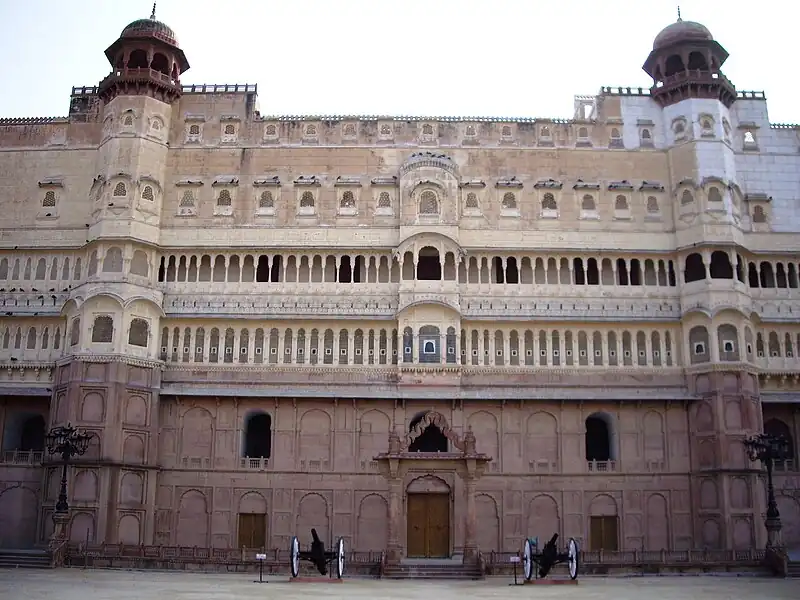 Entrance eastern façade of the Junagarh Fort. Historical records reveal that despite the repeated attacks by enemies to capture the fort, it was not taken, except for a lone one-day occupation by Mughal prince Kamran Mirza.
Entrance eastern façade of the Junagarh Fort. Historical records reveal that despite the repeated attacks by enemies to capture the fort, it was not taken, except for a lone one-day occupation by Mughal prince Kamran Mirza.
Sayyid Dynasty
The Delhi Sultanate took advantage of Rao Jodha's war with Rana Kumbha and captured several Rathore strongholds, including Nagaur, Jalore and Siwana. A few years later, Rao Jodha formed an alliance with several Rajput clans, including the Deora and Bhati, and attacked the Delhi army. He succeeded in capturing Merta, Phalodi, Pokran, Bhadrajun, Sojat, Jaitaran, Siwana, Nagaur and Godwar from the Delhi Sultanate. These areas were permanently captured from Delhi and became a part of Marwar.[26]
Lodi Dynasty
Rajputs under Rana Sanga managed to defend and expand their confederation against Sultanates of Malwa, Gujarat and also against Pashtuns Ibrahim Lodi, Sultan of Delhi. Sanga defeated Ibrahim Lodi in two major battles at Khatoli and Dholpur. The Rana annexed Delhi territory up to Pilia Khar, a river on the outskirts of Agra.[27]
Gujarat Sultanate
Gujarat was ruled by Muzaffarid dynasty from 1407 to 1573. Ahmad Shah II, the sultan of Gujarat, captured Sirohi and attacked Kumbhalmer in reaction to Rana Kumbha's meddling in the affairs of the Nagaur Sultanate. Mahmud Khalji, the Sultan of Malwa and Ahmad Shah II reached an agreement, the treaty of Champaner. Under this, they agreed to attack Mewar and divide the winnings. Ahmad Shah II captured Abu, but was unable to capture Kumbhalmer, and his advance towards Chittor was also blocked. Rana Kumbha allowed the army to approach Nagaur, when he came out, and after a severe engagement, inflicted a crushing defeat on the Gujarat army, annihilating it. Only remnants of it reached Ahmedabad, to carry the news of the disaster to the Sultan.[28]
In a series of battles of Idar from 1514 to 1517, the forces of Rana Sanga of Mewar defeated the forces of Sultan of Gujarat. In 1520, Rana Sanga led a coalition of Rajput forces to invade Gujarat. He defeated the Sultan's army under the command of Nizam Khan and plundered the wealth of the Gujarat Sultanate. Muzaffar Shah II, the Sultan of Gujarat, fled to Champaner.
Rana also defeated the joint forces of Gujarat and Malwa Sultanates in the Siege of Mandsaur and the Battle of Gagron. In 1526, Rana gave protection to the fleeing Gujarat princes. The Sultan of Gujarat demanded their return and after the refusal from the Rana, sent his general Sharza Khan Malik Latif to bring the Rana to terms. In the battle that followed, Latif and 1700 of the Sultan's soldiers were killed, and the rest were forced to retreat to Gujarat.
Malwa Sultanate
Rana Kshetra Singh increased his fame by defeating the Sultan of Malwa and killing his general Ami Shah.
Sultan Mahmud Khilji sent his army with Sultan of Gujarat against Maharana Kumbha which was defeated by Kumbha at the Battle of Nagaur in 1455.[29] Rana Kumbha further defeated Mahmud in Battle of Sarangpur, Sultan of Malwa was captured and was kept as a prisoner in Chittorgarh for six months. He was released after his assurance of future good behaviour. Rana kept his son as hostage to ensure this.
Rana Sanga defeated the joint forces of Gujarat and Malwa Sultanates in the Siege of Mandsaur and the Battle of Gagron. Sanga's continued invasions in Malwa led to the complete destruction of the Malwa Sultanate and establishment of Rajput rule.[30] Sanga placed Medini Rai as King of Malwa with capital at Chanderi. while Silhaditya Tomar establish himself as master of Raisen and Sarangpur region. According to historian Satish Chandra this events took place between 1518 and 1519.[31]
After the victory and restoring Hindu rule in Malwa, Sanga ordered Rai to remove Jizya tax from Hindus of the region.
Nagaur Sultanate
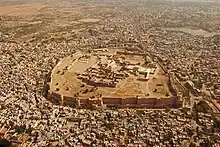
The ruler of Nagaur, Firuz (Firoz) Khan died around 1453–1454. Shams Khan, his son, initially sought the help of Rana Kumbha against his uncle Mujahid Khan, who had occupied the throne. After Shams Khan became the Sultan of Nagaur with the help of Rana Kumbha, he refused to weaken his defenses as promised to Rana, and sought the help of Ahmad Shah II, the Sultan of Gujarat. Angered by this, Kumbha captured Nagaur in 1456, and also Kasili, Khandela and Sakambhari.
Rana Kumbha took away from the treasury of Shams Khan a large store of precious stones, jewels and other valuable things. He also carried away the gates of the fort and an image of Hanuman from Nagaur, which he placed at the principal gate of the fortress of Kumbhalgarh, calling it the Hanuman Pol. Nagaur Sultanate ceased to exist after this disaster.
Jaunpur Sultanate
In the eastern regions of the subcontinent, the Ujjainiya Rajputs of Bhojpur came into conflict with the Jaunpur Sultanate. After a prolonged struggle, the Ujjainiyas were driven into the forest where they continued to carry out a guerrilla resistance.[32]
Mughal Empire
Taking advantage of the instability in Punjab, the ambitious Timurid prince, Babur invaded Hindustan and defeated Ibrahim Lodi at the First Battle of Panipat on 21 April 1526.[33] Rana Sanga rallied a Rajput army to challenge Babur. Babur defeated the Rajputs at the Battle of Khanwa on 16 March 1527, with his superior techniques and military capabilities.
Rajputs at the rise of the Mughals

Soon after his defeat in 1527 at the Battle of Khanwa, Rana Sanga died in 1528. Bahadur Shah of Gujarat became a powerful Sultan. He captured Raisen in 1532 and defeated Mewar in 1533. He helped Tatar Khan to capture Bayana, which was under Mughal occupation. Humayun sent Hindal and Askari to fight Tatar Khan. At the battle of Mandrail in 1534, Tatar Khan was defeated and killed. Puranmal, the Raja of Amber, helped the Mughals in this battle. He was killed in this battle. Meanwhile, Bahadur Shah started his campaign against Mewar and led his army against the fort of Chittorgarh, the defense of the fort was led by, Rani Karnavati, widow of Rana Sanga, she started preparing for a siege and smuggled her young children to the safety of Bundi. Mewar was weakened due to constant struggles. After the Siege of Chittorgarh (1535), Rani Karnavati, together with other women, committed Jauhar. The fort was soon re-captured by the Sisodia's. Babur's grandson, Akbar, tried to persuade Mewar to accept Mughal sovereignty, like other Rajputs, but Rana Udai Singh refused. Ultimately Akbar besieged the fort of Chittor leading to the Siege of Chittorgarh (1567–1568). This time, Rana Udai Singh was persuaded by his nobles to leave the fort with his family. Jaimal Rathore of Merta and Fatah Singh of Kelwa were left to take care of the fort. On 23 February 1568, Akbar shot Jaimal Rathore with his musket, when he was looking after the repair work. That same night, the Rajput women committed jauhar (ritual suicide) and the Rajput men, led by the wounded Jaimal and Fateh Singh, fought their last battle. Akbar entered the fort, and at least 30,000 civilians were killed. Later Akbar placed a statue of these two Rajput warriors on the gates of Agra Fort.
Akbar and Rajputs
Mewar

Akbar won the fort of Chittorgarh, but Rana Udai Singh was ruling Mewar from other places. On 3 March 1572 Udai Singh died, and his son, Maharana Pratap, sat on the throne at Gogunda. He vowed that he would liberate Mewar from the Mughals; until then he would not sleep on a bed, would not live in a palace, and would not have food on a plate (thali). Akbar tried to arrange a treaty with Maharana Pratap, but did not succeed. Finally, he sent an army under Raja Man Singh in 1576. Maharana Pratap was defeated at the Battle of Haldighati in June 1576. However he escaped from the battle and started guerrilla warfare with the Mughals . After years of struggling, Maharana Pratap was able to defeat the Mughals at the Battle of Dewair (not to be confused with the battle of Dewar which was fought by his son Rana Amar Singh). The Badgujars/Sikarwar were the main allies of the Ranas of Mewar. Maharana Pratap died on 19 January 1597, and Rana Amar Singh succeeded him. Akbar sent Salim to attack Mewar in October 1603, but he stopped at Fatehpur Sikri and sought permission from the emperor to go to Allahabad, and went there. In 1605 Salim sat on the throne and took the name of Jahangir.
Marwar
Chandrasen Rathore, the ruler of Marwar defended his kingdom for nearly two decades against relentless attacks from the Mughal Empire. Mughals were not able to establish their direct rule in Marwar during Chandrasen's lifetime.[34]
Jahangir and Mewar
Jahangir sent an army under his son Parviz to attack Mewar in 1606 which was defeated in the Battle of Dewar. The Mughal emperor sent Mahabat Khan in 1608. He was recalled in 1609, and Abdulla Khan was sent. Then Raja Basu was sent, and Mirza Ajij Koka was sent. No conclusive victory could be achieved. The disunity among various Rajput clans didn't allow Mewar to be completely liberated. Ultimately Jahangir himself arrived at Ajmer in 1613, and appointed Shazada Khurram to capture Mewar. Khurram devastated the areas of Mewar and cut the supplies to the Rana. With the advice of his nobles and the crown prince, Karan Singh, the Rana sent a peace delegation to Prince Khurram, Jahangir's son. Khurram sought approval of the treaty from his father at Ajmer. Jahangir issued an order authorising Khurram to agree to the treaty. The treaty was agreed between Rana Amar Singh and Prince Khurram in 1615.
- The Rana of Mewar accepted Mughal suzereignty.
- Mewar and the fort of Chittorgarh was returned to Rana.
- The fort of Chittorgarh could not be repaired or renovated by Rana.
- The Rana of Mewar would not attend the Mughal court personally. The crown prince of Mewar would attend the court and give himself and his army to the Mughals.
- There would be no matrimonial alliance of Mewar with the Mughals.
- 1500 Mewari soldiers to be sent under Mughal service whenever needed.
This treaty, considered respectable for mewar, ended the 88-year-long enmity between Mewar and the Mughals.
Aurangzeb and Rajput rebellion
The Mughal emperor Aurangzeb (1658–1707), who was far less tolerant of Hinduism than his predecessors, placed a Muslim on the throne of Marwar when the childless Maharaja Jaswant Singh died. This enraged the Rathores, and when Ajit Singh, Jaswant Singh's son, was born after his death, the Marwar nobles asked Aurangzeb to place Ajit on the throne. Aurangzeb refused, and tried to have Ajit assassinated. Durgadas Rathore and the dhaa maa (wet nurse) of Ajit, Goora Dhaa (the Sainik Kshatriya Gehlot Rajputs of Mandore), and others smuggled Ajit out of Delhi to Jaipur, thus starting the thirty-year Rajput rebellion against Aurangzeb. This rebellion united the Rajput clans, and a triple-pronged alliance was formed by the states of Marwar, Mewar, and Jaipur. One of the conditions of this alliance was that the rulers of Jodhpur and Jaipur should regain the privilege of marriage with the ruling Sisodia dynasty of Mewar, on the understanding that the offspring of Sisodia princesses should succeed to the throne over any other offspring.
Chhatrasal and the Bundelas
The Bundelas of Chhatrasal waged war against the Mughals and after leading a successful rebellion established his own kingdom which extended over most of the Bundelkhand.[35]: 187–188
See also
References
- ↑ Kim, Hyun Jin (19 November 2015). The Huns. Routledge. pp. 62–64. ISBN 978-1-317-34091-1.
Although it is not certain, it also seems likely that the formidable Gurjara Pratihara regime (ruled from the seventh-eleventh centuries AD) of northern India, had a powerful White Hunnic element. The Gurjara Pratiharas who were likely created from a fusion of White Hunnic and native Indian elements, ruled a vast Empire in northern India, and they also halted Arab Muslim expansion in India through Sind for centuries...
- ↑ Wink, André (1991). Al-hind: The Making of the Indo-islamic World. BRILL. p. 279. ISBN 978-90-04-09249-5.
- ↑ Sircar, Dineschandra (1971). Studies in the Geography of Ancient and Medieval India. Motilal Banarsidass. p. 146. ISBN 9788120806900.
- ↑ Sailendra Nath Sen (1999). Ancient Indian History and Civilization. New Age International. p. 307. ISBN 978-81-224-1198-0.
The anarchy and confusion which followed Harsha's death is the transitional period of Indian history. This period was marked by the rise of the Rajput clans who begin to play a conspicuous role in the history of northern and western India from the eighth century A.D. onwards
- ↑ Alain Danielou (2003). A Brief History of India. Simon and Schuster. p. 87. ISBN 978-1-59477-794-3.
The Rajputs The rise of Rajputs in the history of northern and central India is considerable, as they dominated the scene between the death of Harsha and establishment of Mughal empire
- ↑ Brajadulal Chattopadhyaya (2006). Studying Early India: Archaeology, Texts and Historical Issues. Anthem. p. 116. ISBN 978-1-84331-132-4.
The period between the seventh and the twelfth century witnessed gradual rise of a number of new royal-lineages in Rajasthan, Gujarat, Madhya Pradesh and Uttar Pradesh, which came to constitute a social-political category known as 'Rajput'. Some of the major lineages were the Pratiharas of Rajasthan, Uttar Pradesh and adjacent areas, the Guhilas and Chahamanas of Rajasthan, the Caulukyas or Solankis of Gujarat and Rajasthan and the Paramaras of Madhya Pradesh and Rajasthan.
- ↑ Eugenia Vanina (2012). Medieval Indian Mindscapes: Space, Time, Society, Man. Primus Books. p. 140. ISBN 978-93-80607-19-1.
By the period of seventh–eights centuries AD when the first references to the Rajput clans and their chieftains were made
- ↑ Somani 1976, p. 45.
- ↑ Wink 1990, p. 208 "The Rajputs repelled Arabs from "Stravani and Valla", probably the area North of Jaisalmer and Jodhpur, and the invasion of Malwa but were ultimately defeated by Bappa Rawal and Nagabhata I in 725 AD near Ujjain. Arab rule was restricted to the west of Thar desert."
- 1 2 3 4 Singh, R. B. (1964). History of the Chāhamānas. N. Kishore. pp. 88–140.
- ↑ Chandra 2006, pp. 19–24.
- ↑ Majumdar 1956, pp. 44–45.
- ↑ Chandra 2006, p. 29.
- ↑ Sharma, Dasharatha (1975) [1959]. Early Chauhān Dynasties: A Study of Chauhān Political History, Chauhān Political Institutions, and Life in the Chauhān Dominions, from 800 to 1316 A.D. Motilal Banarsidass. ISBN 978-0-8426-0618-9.
- ↑ Sharma 1975, pp. 60–61.
- ↑ Chandra 2006, pp. 25–26.
- ↑ Singh 1964, pp. 199–202, 461.
- ↑ Sarkar 1960, pp. 37.
- ↑ Rima Hooja (2006). A HISTORY OF RAJASTHAN (PB). Rupa & Company. p. 263. ISBN 978-81-291-1501-0.
- 1 2 Chandra 2006, p. 27.
- ↑ V.S Bhatnagar (1974). Life and Times of Sawai Jai Singh, 1688-1743. Impex India. p. 6.
From 1326, Mewar's grand recovery commenced under Lakha, and later under Kumbha and most notably under Sanga, till it became one of the greatest powers in northern India during the first quarter of sixteenth century.
- ↑ Chandra 2006, p. 86.
- ↑ Chandra 2006, p. 97.
- ↑ "Rajput". Encyclopædia Britannica. Retrieved 27 November 2010.
- ↑ R. C. Majumdar, ed. (1960). The History and Culture of the Indian People: The Delhi Sultante (2nd ed.). Bharatiya Vidya Bhavan. p. 70.
- ↑ Kothiyal, Tanuja (2016). Nomadic Narratives: A History of Mobility and Identity in the Great Indian. Cambridgr University Press. p. 76. ISBN 9781107080317. Retrieved 17 September 2020.
- ↑ Chandra 2006, p. 224.
- ↑ Sarda, Harbilas (March 2007). Maharana Kumbha: Sovereign, Soldier, Scholar. Read Books. p. 56. ISBN 978-1-4067-3264-1.
- ↑ Sarda, Harbilas (March 2007). Maharana Kumbha: Sovereign, Soldier, Scholar. Read Books. p. 55. ISBN 978-1-4067-3264-1.
- ↑ Sharma 1970, p. 27 "The early 16th century marks the rise of Patriotic one eyed chief of Mewar named as Rana Sanga who defeat several of his neighbour kingdom and establish Rajput hold on Malwa first time after fall of Parmara dynasty through series of victories over Malwa, Gujarat and Delhi Sultanate"
- ↑ Satish Chandra (2003). Essays on Medieval Indian History. Oxford University Press. p. 362. ISBN 978-0-19-566336-5.
Rana Sanga of Mewar came in conflict with Sultanates of Malwa, Gujarat and Delhi and repelled all of their invasions. An ensuring battle was fought in Gagron along with other skirmishes in which Rana came Victorious and Subsequently Eastern and Northern Malwa passed under Control of Rana. These events are placed in 1518-19"
- ↑ Dirk H. A. Kolff (8 August 2002). Naukar, Rajput, and Sepoy: The Ethnohistory of the Military Labour Market of Hindustan, 1450-1850. Cambridge University Press. pp. 60–62. ISBN 978-0-521-52305-9.
- ↑ Chandra 2006, p. 204.
- ↑ Bose, Melia Belli (2015). Royal Umbrellas of Stone: Memory, Politics, and Public Identity in Rajput Funerary Art. BRILL. p. 150. ISBN 978-9-00430-056-9.
- ↑ Sen, Sailendra (2013). A Textbook of Medieval Indian History. Primus Books. ISBN 978-9-38060-734-4.
Bibliography
- Wink, André (1990). Al- Hind: The slave kings and the Islamic conquest. Vol. 1. BRILL. p. 269. ISBN 9789004095090.
- Majumdar, Asoke Kumar (1956). Chaulukyas of Gujarat. Bharatiya Vidya Bhavan. OCLC 4413150.
- Chandra, Satish (2006). Medieval India: From Sultanat to the Mughals (1206–1526). Har-Anand Publications.
- Sarkar, Jadunath (1960). Military History of India. Orient Longmans. ISBN 9780861251551.
- Somani, Ram Vallabh (1976). History of Mewar, from Earliest Times to 1751 A.D. Mateshwari. OCLC 2929852.
- Sharma, Dasharatha (1970). Lectures on Rajput History and Culture. Motilal Banarsidass. ISBN 978-0-8426-0262-4.

